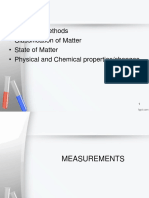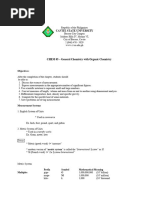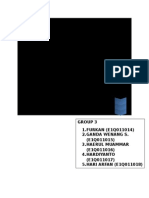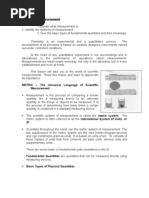CHM-101 Chapter 1
CHM-101 Chapter 1
Uploaded by
razan136Copyright:
Available Formats
CHM-101 Chapter 1
CHM-101 Chapter 1
Uploaded by
razan136Original Title
Copyright
Available Formats
Share this document
Did you find this document useful?
Is this content inappropriate?
Copyright:
Available Formats
CHM-101 Chapter 1
CHM-101 Chapter 1
Uploaded by
razan136Copyright:
Available Formats
GENERAL CHEMISTRY I
(CHM-101)
CHAPTER ONE
Chemistry:
The Study Of Change
Chemistry:
Is the study of Matter and Its Changes
Matter is anything that has mass and also
volume.
Mass is the measure of the amount of matter in
an object.
Weight is the measure of the gravitational
force for the matter in an object.
Conversion Factors
Units of length
1 m = 10 dm = 10
2
cm = 10
3
mm = 10
9
nm.
Units of time
1 s = 10
3
ms = 10
6
s = 10
9
ns = 10
12
ps = 10
15
fs.
Units of weight
1g = 10
3
mg = 10
6
g = 10
9
ng.
Units of volume
1L = 1dm
3
= 10
3
cm
3
= 10
3
mL; 1 mL = 1 cm
3
; 1 m
3
= 10
6
cm
3
= 10
3
dm
3
= 10
3
L
where: L = Liter; mL = milliliter; d = deci; c = centi; m =
meter; g = gram; n = nano; = micro, f = femto, p = pico.
Are those digits in a measured number (or
result of the calculation with a measured
number) that include all certain digits plus a
final one having some uncertainty OR The
number of digits necessary to express the
results of a measurement consistent with the
measured precision.
General Rules
Zeros to the right of the decimal and at the
same time to the right of the nonzero number
are significant
Any number that is nonzero is significant.
Zeros between nonzero numbers are
significant.
Zeros at the beginning of a number are never
significant.
Zeros at the right of the decimal and at the
same time to the right of the nonzero number
are significant.
Examples: How many significant figures are
there in each of the following measurements?
0.0351 (3 sig. figs)
0.30210 (5 sig. figs)
52000 (2 sig. figs)
52.000 (5 sig. figs)
010850 (4 sig. figs)
Scientific Notation
A x 10
n
1 A < 10
n is a positive or negative integer
Every digit included in A is significant
Example: The integer number 100 could have
2 or 3 significant figures. It should be written in
one of the following ways:
1.00 x 10
2
(3 sig. figs) but NOT 10.0 x 10
1
1.0 x 10
2
(2 sig. figs) but NOT 0.10 x 10
3
Rounding-off
Zeros to the right of the decimal and at the
same time to the right of the nonzero number
are significant
If the first digit in the part of the number to be
dropped is 5 or greater than 5, increase the
previous digit by 1, then remove the excess
digits.
If the first digit in the part of the number to
be dropped is less than 5, simply remove the
excess digits.
Examples:
3.56343 3.56 (if rounded to 3 sig. figs)
3.56843 3.57 (if rounded to 3 sig. figs)
3.57500 3.58 (if rounded to 3 sig. figs)
Significant Figures
in Multiplication & Division
Example: 0.41 x 2.546 x (3.12 x10
6
) =
7.0012
465183.5687 (calculator answer)
In multiplication and division, the answer should
contain same significant figures as the measurement
with the smaller number of significant figures.
The correct answer should have 2 sig. figs (4.7 x 10
5
)
*(Do not round off each step)
Significant Figures
in Addition & Substraction
Example: 937.3 + 15.224 + 71.04 = 1023.564 (calculator
answer)
In addition and subtraction, the final answer must have
same number of decimal places as the least precise
measurement that is, the measurement with the smallest
number of the decimal places.
The correct answer cannot have more than one
number to the right of the decimal point.
Therefore, the sum, 1023.564, should be rounded
to 1023.6
The answer should read 0.0070 (2 sig. figs).
Example: 8.9250 - 8.904 = 0.021 = 0.007 (calculator answer)
3 3
Exact
Temperature Scales
Celsius to Kelvin Conversion
Celsius to Fahrenheit Conversion
K =
o
C + 273
o
F = (9/5)
o
C + 32
CLASSIFICATION
OF MATTERS
Liquid: molecules are
close together but not held
rigidly in a fixed position.
Gas: molecules are far away
from each other.
Solid: molecules are close
together with little freedom
of motion.
Solids: are rigid and have a definite
shape and volume.
Liquids: have definite volume but no
definite shape (take the shape of the container).
Gases: have no definite shape or
volume (takes the shape and volume of the
container). Gases can be compressed to form
liquids.
Matter
Mixtures
Pure
substances
Homogeneous
mixtures
Heterogeneous
mixtures
Compounds Elements
Separation by
physical methods
Separation by
chemical methods
Matter
Uniform throughout
Not uniform throughout
Heterogeneous mixture
Homogeneous matter
cannot be separated by
physical means
can be separated by physical means
Pure substance
Homogeneous mixture
can be decomposed
into something else
by chemical means
Compound
cannot be decomposed
into something else by
chemical means
Element
DENSITY
(g/mL or g/cm
3
)
Density has many uses:
A tool for identification of substances.
To determine the amount of antifreeze & thus the level
of protection against freezing, in the cooling system of
a car.
The liquid in your cars lead storage battery (a solution
of H
2
SO
4
) changes the density because H
2
SO
4
is
consumed as the battery discharges.
In a fully charged battery, density (solution) = 1.30 g/cm
3
If the density falls below 1.20 g/cm
3
, this means that the
battery will have to be charged.
You might also like
- GRE - Quantitative Reasoning: QuickStudy Laminated Reference GuideFrom EverandGRE - Quantitative Reasoning: QuickStudy Laminated Reference GuideNo ratings yet
- Cosmological Perturbation Theory, Part 1 - Hannu Kurki PDFNo ratings yetCosmological Perturbation Theory, Part 1 - Hannu Kurki PDF97 pages
- Unit 1: Introduction To Chemistry: Pre-Ap Chemistry Edmond Northhigh School Chapters: 1 & 2No ratings yetUnit 1: Introduction To Chemistry: Pre-Ap Chemistry Edmond Northhigh School Chapters: 1 & 275 pages
- CHEM 111-2: General Chemistry I: Instructor: Dr. Fatma Melis ÇağdaşNo ratings yetCHEM 111-2: General Chemistry I: Instructor: Dr. Fatma Melis Çağdaş50 pages
- Some Basic Concepts of Chemistry BY JNV TEACHERNo ratings yetSome Basic Concepts of Chemistry BY JNV TEACHER40 pages
- Chapter 2: Measurements and CalculationsNo ratings yetChapter 2: Measurements and Calculations62 pages
- Group 3 1.FURKAN (E1Q011014) 2.ganda Wenang S. (E1Q011015) 3.haerul Muammar (E1Q011016) 4.hardiyanto (E1Q011017) 5.HARI ARFAN (E1Q011018) HILFAN (E1Q011018)No ratings yetGroup 3 1.FURKAN (E1Q011014) 2.ganda Wenang S. (E1Q011015) 3.haerul Muammar (E1Q011016) 4.hardiyanto (E1Q011017) 5.HARI ARFAN (E1Q011018) HILFAN (E1Q011018)8 pages
- Lab 2 CHM130LL Measurements and Significant Figures W AnswersNo ratings yetLab 2 CHM130LL Measurements and Significant Figures W Answers8 pages
- METRIC - The Universal Language of Scientific MeasurementNo ratings yetMETRIC - The Universal Language of Scientific Measurement8 pages
- Fall 2020 CHE 121L Lab 1 Scientific Notation Sig FigNo ratings yetFall 2020 CHE 121L Lab 1 Scientific Notation Sig Fig10 pages
- Chapter 1: Matter, Energy, and The Origins of The UniverseNo ratings yetChapter 1: Matter, Energy, and The Origins of The Universe62 pages
- Chapter 1 Some Basic Concepts of Chemistry New1 (1) - CopyNo ratings yetChapter 1 Some Basic Concepts of Chemistry New1 (1) - Copy20 pages
- Chapter 2: Metric System, Conversion and Uncertainty of MeasurementsNo ratings yetChapter 2: Metric System, Conversion and Uncertainty of Measurements23 pages
- 1 - Units and Measurements, Errors and Dimensional Analysis100% (1)1 - Units and Measurements, Errors and Dimensional Analysis18 pages
- Chemistry Calculations For The Hungarian Chemistry Exam - Kémia Érettségi Számitási Feladatok Angol NyelvenNo ratings yetChemistry Calculations For The Hungarian Chemistry Exam - Kémia Érettségi Számitási Feladatok Angol Nyelven41 pages
- Solid State & Surface Chemistry & Colloids - FNo ratings yetSolid State & Surface Chemistry & Colloids - F4 pages
- ESD Protection Circuits For Advanced CMOS TechnologiesNo ratings yetESD Protection Circuits For Advanced CMOS Technologies137 pages
- In-Place Hot-Mix Asphalt Density Estimation Using Ground Penetrating RadarNo ratings yetIn-Place Hot-Mix Asphalt Density Estimation Using Ground Penetrating Radar20 pages
- "Man Is A Political Animal": - AristotleNo ratings yet"Man Is A Political Animal": - Aristotle17 pages
- ICHIRO GENBU (ICR-6122 6131) : Product DescriptionNo ratings yetICHIRO GENBU (ICR-6122 6131) : Product Description2 pages
- Denia Math 10 SL Math Investigation 10 2No ratings yetDenia Math 10 SL Math Investigation 10 216 pages
- MT Training Evaluation Exam Name Date: ExaminerNo ratings yetMT Training Evaluation Exam Name Date: Examiner5 pages
- Simulation For Thermomechanical Behavior of Shape 1No ratings yetSimulation For Thermomechanical Behavior of Shape 16 pages
- Stiffened Elements With Multiple Intermediate Stiffeners and EdgeNo ratings yetStiffened Elements With Multiple Intermediate Stiffeners and Edge13 pages
- DOE HDBK-1169-2003 - Nuclear Air Cleaning Handbook100% (2)DOE HDBK-1169-2003 - Nuclear Air Cleaning Handbook403 pages
- Mechanics and Physics of Fracture: Multi-Scale Modeling of The Failure Behaviour of SolidsNo ratings yetMechanics and Physics of Fracture: Multi-Scale Modeling of The Failure Behaviour of Solids3 pages
- Forces and Motion Using Part 2 - FrictionNo ratings yetForces and Motion Using Part 2 - Friction3 pages
- Design of An Impact Attenuator For A Formula SAE CarNo ratings yetDesign of An Impact Attenuator For A Formula SAE Car3 pages
- Basic Principles of Coordinate Measuring Machines100% (1)Basic Principles of Coordinate Measuring Machines31 pages
- GRE - Quantitative Reasoning: QuickStudy Laminated Reference GuideFrom EverandGRE - Quantitative Reasoning: QuickStudy Laminated Reference Guide
- Cosmological Perturbation Theory, Part 1 - Hannu Kurki PDFCosmological Perturbation Theory, Part 1 - Hannu Kurki PDF
- Unit 1: Introduction To Chemistry: Pre-Ap Chemistry Edmond Northhigh School Chapters: 1 & 2Unit 1: Introduction To Chemistry: Pre-Ap Chemistry Edmond Northhigh School Chapters: 1 & 2
- CHEM 111-2: General Chemistry I: Instructor: Dr. Fatma Melis ÇağdaşCHEM 111-2: General Chemistry I: Instructor: Dr. Fatma Melis Çağdaş
- Group 3 1.FURKAN (E1Q011014) 2.ganda Wenang S. (E1Q011015) 3.haerul Muammar (E1Q011016) 4.hardiyanto (E1Q011017) 5.HARI ARFAN (E1Q011018) HILFAN (E1Q011018)Group 3 1.FURKAN (E1Q011014) 2.ganda Wenang S. (E1Q011015) 3.haerul Muammar (E1Q011016) 4.hardiyanto (E1Q011017) 5.HARI ARFAN (E1Q011018) HILFAN (E1Q011018)
- Lab 2 CHM130LL Measurements and Significant Figures W AnswersLab 2 CHM130LL Measurements and Significant Figures W Answers
- METRIC - The Universal Language of Scientific MeasurementMETRIC - The Universal Language of Scientific Measurement
- Fall 2020 CHE 121L Lab 1 Scientific Notation Sig FigFall 2020 CHE 121L Lab 1 Scientific Notation Sig Fig
- Chapter 1: Matter, Energy, and The Origins of The UniverseChapter 1: Matter, Energy, and The Origins of The Universe
- Chapter 1 Some Basic Concepts of Chemistry New1 (1) - CopyChapter 1 Some Basic Concepts of Chemistry New1 (1) - Copy
- Chapter 2: Metric System, Conversion and Uncertainty of MeasurementsChapter 2: Metric System, Conversion and Uncertainty of Measurements
- 1 - Units and Measurements, Errors and Dimensional Analysis1 - Units and Measurements, Errors and Dimensional Analysis
- Chemistry Calculations For The Hungarian Chemistry Exam - Kémia Érettségi Számitási Feladatok Angol NyelvenChemistry Calculations For The Hungarian Chemistry Exam - Kémia Érettségi Számitási Feladatok Angol Nyelven
- GCSE Maths Revision: Cheeky Revision ShortcutsFrom EverandGCSE Maths Revision: Cheeky Revision Shortcuts
- ESD Protection Circuits For Advanced CMOS TechnologiesESD Protection Circuits For Advanced CMOS Technologies
- In-Place Hot-Mix Asphalt Density Estimation Using Ground Penetrating RadarIn-Place Hot-Mix Asphalt Density Estimation Using Ground Penetrating Radar
- ICHIRO GENBU (ICR-6122 6131) : Product DescriptionICHIRO GENBU (ICR-6122 6131) : Product Description
- Simulation For Thermomechanical Behavior of Shape 1Simulation For Thermomechanical Behavior of Shape 1
- Stiffened Elements With Multiple Intermediate Stiffeners and EdgeStiffened Elements With Multiple Intermediate Stiffeners and Edge
- DOE HDBK-1169-2003 - Nuclear Air Cleaning HandbookDOE HDBK-1169-2003 - Nuclear Air Cleaning Handbook
- Mechanics and Physics of Fracture: Multi-Scale Modeling of The Failure Behaviour of SolidsMechanics and Physics of Fracture: Multi-Scale Modeling of The Failure Behaviour of Solids
- Design of An Impact Attenuator For A Formula SAE CarDesign of An Impact Attenuator For A Formula SAE Car

























































































